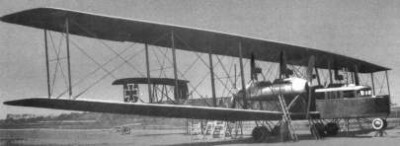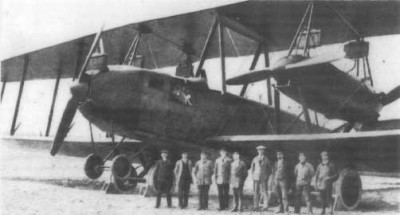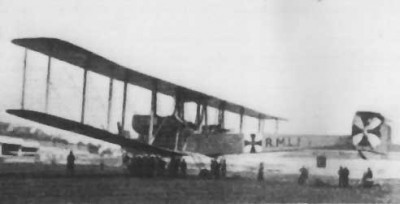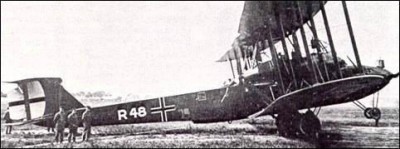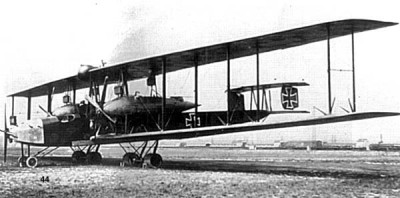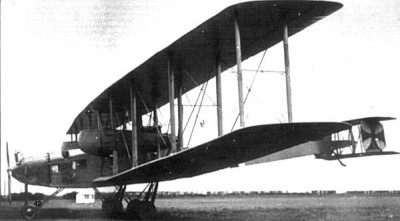Zeppelin typy V.G.O. a R
The first Zeppelin bomber was the V.G.O. I (Versuchs Gotha Ost). It took off on 11 April 1915, powered by three in-line water-cooled Maybach Mb IV engines, each with 240 hp. One was mounted on the nose as a tractor and the other two on the wings as pushers. The wingspan of this massive machine was 42.2 metres. It was assigned to the Naval Air Force and bore the designation RML.1 (Reichs Marine Landflugzeug 1) on the fuselage. Piloted by C. Kuring and W. Mann under the command of Rasch, it flew from the factory to the Eastern Front in June 1916.
The second bomber was the V.G.O. II, serial number R.9/15, which was virtually identical to the V.G.O. I but was assigned to the Army Air Corps. Both operated on the Russian front, where they bombed Russian infantry positions as early as 13 August 1916. The V.G.O. I took three hits from anti-aircraft gunners in the wing during the next bombardment on 18 August, but the pilot managed to return to the airfield with the damaged aircraft. Later, V.G.O.II was classified as a trainer. The V.G.O. I and II machines were not considered sufficiently capable for combat deployment.
This was followed by the V.G.O. III, serial number R.10/15, powered by six Mercedes in-line engines, each with 160 hp. Two engines in pairs each turned a twin-bladed propeller. This aircraft was deployed on the Eastern Front with Riesenflugzeugabteilung 500 and 501.
The R.IV (Riesenflugzeug) differed from its predecessor only in the use of the more powerful 220 hp Benz Bz IV engines and the use of a four-bladed wooden propeller.
The defensive armament of all the above mentioned machines consisted of four to six Parabellum machine guns of 7.92 mm calibre. The machine guns were located in the front of the engine nacelles and in the rear of the fuselage.
In 1917, the R.V appeared, powered by five 250 hp Maybach Mb IV engines. A single engine powered the four-bladed propeller on the bow, and the four-bladed trailing edge propellers on the wings were also powered by a pair of engines each time. This change necessitated a change in firing stations. The machine guns were now located in the rear of the engine nacelles and the forward sphere coverage was now provided by a machine gun located in the centre of the upper wing more than 6 metres above the ground (swallow's nest).
The R.IV and R.V operated on the eastern front from Vilnius airport from where they raided military installations, railway junctions and also Russian naval bases in the Gulf of Riga. None of the machines were lost in combat operations until peace was concluded. The R.V was the first Zeppelin bomber to be deployed on the Western Front. However, its weight required deployment only at specially adapted airfields.
All the V.G.O. I to R.V machines were built as prototypes in only one example. They were biplanes with a six-wheel nose landing gear with a spur on the stern. The engine nacelles were mounted on spars between the wings with a span of 42.2 metres and a carrying area of 334 m2. The aircraft was 22.1 metres long and 6.3 metres high. The rear section was also in a two-plane configuration with two rudders. The Type R.IV had an empty weight of 7,660 kg and a take-off weight of 11,400 kg. The gunners in the powered nacelles were also the mechanics who took care of the engines during the flight. The engine nacelle itself was larger than many fighters of the time, indicating the massiveness of these machines. The wingspan was almost the same as that of the Boeing B-29 Superfortress (43.05 m).
The first "mass-produced" Zeppelin bomber was the R.VI. A total of 18 machines of this type were produced. Propulsion was provided by four water-cooled Maybach Mb IVa engines, each with 245 hp. The arrangement was changed; two engines powered the trailing propellers and two engines the pusher propellers. A fixed triangular stabilizer was added at the tail. The pilots' seat was in an enclosed cabin. The gunners kept their stations on the nose and stern of the fuselage open at all times. The armament consisted of four 7.92 mm Parabellum machine guns. The bomber could carry up to 2,000 kg of bombs, the actual amount depending on the type and distance of the target.
The next in the line of Zeppelin bombers was the Type R.VII, which was very similar to the Type R.IV. It was slightly shorter and lighter. The design of the rear section also underwent minor changes.
The Type R.XIV was produced in three examples. One of these bombers was shot down in France near Etaples on 23 July 1918 by a Sopwith Camel fighter piloted by Captain Yaille of 151 Squadron RAF. Five engines were used in this type. In addition to the same engine configuration as the R.VI, an engine was added to power the nose thrust propeller.
The Type R.XV was essentially the same as the Type R.XIV. Due to the approaching end of the war, it did not see significant operational use. After the war it was transported to Japan. The R.XIV and R.XV were powered by four 245 hp Maybach Mb IV engines and were armed with five machine guns. According to surviving photographs, the propellers were apparently two-bladed thrust propellers and four-bladed pusher propellers. A fixed triangular stabilizer was again used on the tail.
The last type was the R.XVI(Av) produced at the Aviatik factory. It was powered by four engines. Two Benz Bz VI with 530 hp and two Benz IVa with 220 hp. They powered the propellers in a pulling and pushing configuration as in the R.IV type. Two stand-ups were built. The first flew in October 1918. During a test flight the landing gear was damaged and the aircraft was never repaired. The second was flown after the end of the war without armament as a civilian machine.
Sources used:
[1] COOKSLEY, Peter. German Bombers of WWI in Action: Aircraft nrumber 173. Squadron/Signal Publications, Inc. 2000, ISBN 0-89747-416-3
[2] www.airwar.ru
This post has not been translated to English yet. Please use the TRANSLATE button above to see machine translation of this post.
| Period | - |
| Producer | - |
| Type | - |
| Camouflage | - |
| Country | - |
| Pilot | - |
| Production No. | - |
| Serial No. / Evidence No. | - |
| Tactical Marking / Imatriculation | - |
| Name | - |
| Unit | - |
| Base | - |
| Date (DD.MM.RRRR) | - |
| Author | - |
| Print size / 300 DPI | - |
| Published with authors permit | - |
| Author Website | - |
Zeppelin-Staaken R.VI
| Period | - |
| Producer | - |
| Type | - |
| Camouflage | - |
| Country | - |
| Pilot | - |
| Production No. | - |
| Serial No. / Evidence No. | - |
| Tactical Marking / Imatriculation | - |
| Name | - |
| Unit | - |
| Base | - |
| Date (DD.MM.RRRR) | - |
| Author | - |
| Print size / 300 DPI | - |
| Published with authors permit | - |
| Author Website | - |
Zeppelin-Staaken R.XIV
| Period | - |
| Producer | - |
| Type | - |
| Camouflage | - |
| Country | - |
| Pilot | - |
| Production No. | - |
| Serial No. / Evidence No. | - |
| Tactical Marking / Imatriculation | - |
| Name | - |
| Unit | - |
| Base | - |
| Date (DD.MM.RRRR) | - |
| Author | - |
| Print size / 300 DPI | - |
| Published with authors permit | - |
| Author Website | - |
Zeppelin-Staaken V.G.O. I
This post has not been translated to English yet. Please use the TRANSLATE button above to see machine translation of this post.
www.ifb.uni-stuttgart.de/~doerner/
www.geocities.co.jp/Playtown-Dice/2996/
www.airwar.ru
| Period | - |
| Producer | - |
| Type | - |
| Camouflage | - |
| Country | - |
| Pilot | - |
| Production No. | - |
| Serial No. / Evidence No. | - |
| Tactical Marking / Imatriculation | - |
| Name | - |
| Unit | - |
| Base | - |
| Date (DD.MM.RRRR) | - |
| Author | - |
| Print size / 300 DPI | - |
| Published with authors permit | - |
| Author Website | - |
Zeppelin-Staaken R.XVI
| Period | - |
| Producer | - |
| Type | - |
| Camouflage | - |
| Country | - |
| Pilot | - |
| Production No. | - |
| Serial No. / Evidence No. | - |
| Tactical Marking / Imatriculation | - |
| Name | - |
| Unit | - |
| Base | - |
| Date (DD.MM.RRRR) | - |
| Author | - |
| Print size / 300 DPI | - |
| Published with authors permit | - |
| Author Website | - |
Zeppelin-Staaken R.XV
| Period | - |
| Producer | - |
| Type | - |
| Camouflage | - |
| Country | - |
| Pilot | - |
| Production No. | - |
| Serial No. / Evidence No. | - |
| Tactical Marking / Imatriculation | - |
| Name | - |
| Unit | - |
| Base | - |
| Date (DD.MM.RRRR) | - |
| Author | - |
| Print size / 300 DPI | - |
| Published with authors permit | - |
| Author Website | - |
Zeppelin-Staaken R.V
| Period | - |
| Producer | - |
| Type | - |
| Camouflage | - |
| Country | - |
| Pilot | - |
| Production No. | - |
| Serial No. / Evidence No. | - |
| Tactical Marking / Imatriculation | - |
| Name | - |
| Unit | - |
| Base | - |
| Date (DD.MM.RRRR) | - |
| Author | - |
| Print size / 300 DPI | - |
| Published with authors permit | - |
| Author Website | - |
Zeppelin-Staaken V.G.O. III
This post has not been translated to English yet. Please use the TRANSLATE button above to see machine translation of this post.
aeiou.iicm.tugraz.at/aeiou.film.f/f041a.
Join us
We believe that there are people with different interests and experiences who could contribute their knowledge and ideas. If you love military history and have experience in historical research, writing articles, editing text, moderating, creating images, graphics or videos, or simply have a desire to contribute to our unique system, you can join us and help us create content that will be interesting and beneficial to other readers.
Find out more